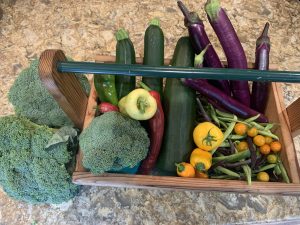August 8, 2022 August Garden Care
August 7, 2022
August Garden Care
“Gardening requires lots of water — most of it in the form of perspiration.”
-Lou Erickson
I was hoping this past week I would be able to take it easy in my garden for a bit. After all the prep work for the SCMGA Garden Tour, I was a little tired. However, my vegetable garden did not get that memo and now my beans, eggplant, broccoli, and zucchini are starting to come on strong. Unfortunately, the humidity doesn’t make it pleasant either. By the time I picked everything Saturday morning, I needed a shower before the hubby and I were able to start processing everything. We froze broccoli, cut up beans for canning, and shredded zucchini for zucchini relish – a famous family recipe that is requested by everyone who has tasted it. I spent Sunday afternoon water bathing zucchini relish and pressure cooking green beans. I still must do something with the eggplant and then hopefully find time to make pesto from the basil that’s growing abundantly. I’m not complaining though, as I consider us fortunate that we’re able to grow an abundance of food for ourselves, family, and friends.
Even though there is an abundance of canning and freezing to be done, there are other gardening tasks to be completed as well. In the flower garden, transplant and divide iris, daylilies, coneflowers, daisies, black-eyed Susans, yarrow and other perennials that have finished their blooming cycle. As I have so many daylilies that are blooming or just finishing up, it’s a good time to see what color they are. Deadhead these perennials to encourage additional blooms: baby’s breath, bee balm, blanket flower, butterfly weed, cheddar pink, delphiniums, false sunflower, foxglove, garden phlox, globe thistle, hollyhock, monkshood, purple coneflower, shasta daisy, speedwell, tickseed, yarrow, and many more. When you cut glad blooms for a bouquet, leave the maximum amount of foliage on the plant. This will allow the gladiolus to store more energy in the corm, leading to better blooming next year. If you have some spectacular or unusual coleus, geraniums, or other plants, take cuttings to be rooted for winter houseplants or for next summer gardens. It’s time to plant mums for fall color. Try to find ones that are labeled as garden mums as they can many times be wintered over with a little extra mulching and winter protection. Don’t forget the weeds – they love hot, humid weather.
Toward the end of the month, divide or plant Oriental poppies. They like hot, sunbaked soil, so don’t mulch them. It’ll also be time to bring your poinsettia back indoors after being outside for the summer. Withhold water from your amaryllis for the next two months to stimulate bloom. I found two in my basement that I accidentally set aside in the wrong location that haven’t received any water for quite some time. I’m not sure they will survive, but I will still try to revive them.
In the vegetable garden, regularly pick vegetables such as beans, cucumbers, tomatoes, zucchini, and others to encourage them to produce more. This goes for herbs as well. If you haven’t already, plant a late crop of radishes, lettuce, spinach, and beets.
Other than regular mowing, there isn’t a lot to do in August lawn maintenance other than thatching. Remove the thatch if it’s more than a half inch thick. Finally, you can plant evergreens now through September.
This week’s article is written by Jeannie Manis, a Wisconsin Certified Sauk County Master Gardener Volunteer. If you have any gardening questions, please contact the Extension Sauk County by emailing to trripp@wisc.edu or calling the University of Wisconsin Madison Division of Extension Sauk County office at 608-355-3250.





